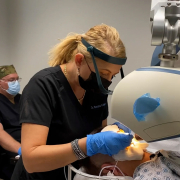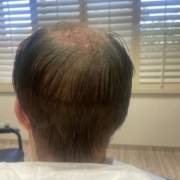Choosing the Best FUE Device for Your Hair Transplant
Choosing the Best FUE Device for Your Hair Transplant: What You Need to Know
The decision to undergo a hair transplant is significant, and choosing the right Follicular Unit Extraction (FUE) device can directly impact your results. With advancements in hair transplant technology, several FUE devices have become available, each with unique features and benefits. However, it’s not just about the technology—your physician’s expertise plays a crucial role.
Popular FUE Devices: An Overview
Each FUE device offers a different approach to follicle extraction, designed to minimize scarring, improve graft quality, or assist in achieving a natural look.
- SAFE System: Developed in 2003, the SAFE system was one of the first to combine sharp and blunt punches, reducing follicle damage and making FUE more mainstream.
- ARTAS Robotic System: This advanced robotic system uses AI to assist physicians in identifying and extracting healthy follicles. ARTAS offers precision, but it still requires a skilled surgeon for optimal results.
- Neograft: This manual device uses air pressure to help extract and implant follicles, requiring a steady hand and skilled surgeon.
- SmartGraft: With a touchscreen interface and temperature-controlled graft storage, SmartGraft is designed to enhance graft health and survival rates.
- Atera FUE-100: This device offers depth control and a unique saline injection system to increase the quality and viability of the extracted follicles.
- Trivellini System: This lightweight system reduces doctor fatigue with customizable settings, providing flexibility during the extraction process.
- WAW System: Known for its “Hybrid Tornado” punch, this device minimizes scarring and trauma to the grafts, leading to better recovery and aesthetics.
- Zeus UGraft System: Designed for graft health with features like a flared punch and hands-free ejection, it offers advanced control and better graft survival rates.
Key Factors to Consider
While device features are essential, they’re only one part of a successful hair transplant. Here are critical factors to consider when choosing both a device and a physician:
- Physician Expertise: A skilled doctor’s experience with FUE devices is as crucial as the technology itself. Ask about your physician’s experience and whether hair transplantation is their primary specialty.
- In-Person Consultations: Avoid relying solely on online photos, as these can be edited. Meeting with your doctor in person provides a more accurate assessment of their skills and device availability.
- Graft Health and Trauma: Devices that minimize graft trauma typically yield better results. Ask your doctor about their chosen device’s impact on graft health and survival rates.
- Patient Testimonials: Research reviews from patients who have undergone procedures with the device you’re considering. Real-life experiences often give you the most candid insights.
A more in-depth look at each device:
SAFE system – FUE device
S.A.F.E. stands for Surgically Advanced Follicular Excision. Dr. James Harris developed the device in 2003. For its time, it was excellent technology: a first in-kind FUE device used to isolate and excise single follicular units. S.A.F.E. introduced a two-step system which combined a hybrid sharp punch with a blunt dual punch to ensure proper penetration. The method lowered the risk of transection (damage to surrounding hair follicles).
S.A.F.E. played a large role in ensuring the eventual mainstream adoption of the FUE technique. It’s simply been made obsolete through technological evolution.
Notable features of this system were:
- It was an industry-defining device.
- It allowed for minimal scarring, setting the standard for all future systems.
- It improved dermal penetration and reduced risks.
- It was the first device to lower transection rates to less than 10%.
A single motorized punch accomplishes the first two steps described above. Rotating quickly, the punch initially cuts through the skin and then, as it passes more deeply, the tissue resistance slows the rotation of the instrument (essentially converting it into a dull punch). Read about the SAFE System. This device was one of the first hand held devices to come to the market.
ARTAS – FUE robotic
The ARTAS® Robotic System is the most advanced technology for surgical hair restoration was introduced in 2011. It aids the physician in performing Follicular Unit Extraction (FUE) hair transplant procedures with accuracy and consistency that allows for maximum preservation of follicles. Punches are 18 and 19 gauge.

Dr Kelemen directing the surgery
Neograft – FUE machine
A hand-held surgical device that extracts follicular units from the donor area and implants them in the recipient area via an air-pressure/suction-based system. The Neograft machine relies on manual control provided by a human operator in order to select and extract follicular unit grafts.
The device is applied to the scalp where it first separates the grafts from the surrounding donor tissue with a rotating sharp punch that is connected to a suction unit. Once the upper part of the graft is dissected by the punch, the suction pulls the graft out, separating it from the remaining tissue.
SmartGraft – FUE
A suction-based system comprised of a handpiece, touchscreen monitor, and follicular unit graft storage chamber. The main component of the system is a unit comprised of the touchscreen monitor and temperature-controlled storage chamber. The unit also provides suction for the handpiece, which connects via a tube. The touchscreen allows the surgeon to control and monitor the rotation speed of the punch, strength of suction, illumination of the scalp, and irrigation of the graft storage canisters.
Atera-FUE 100
The FUE-100 system utilizes a handpiece with depth control and a unique saline injection system that the company claims maximize the viability of follicular unit grafts. The handpiece provides the surgeon with the option of using one of three different size harvesting punches (0.8mm, 0.95mm, and 1.05mm). Like the Neograft and SmartGraft systems, the Atera FUE-100 system uses a single-punch, suction technique.
Trivelinni – FUE handheld device
Trivellini is a handheld device that assists the doctor with the excision of the hair follicles during the FUE method of hair transplant. It’s extremely light weight and relies on the Smart React system instead of a foot pedal. It offers the doctors many variables for the FUE surgery that can complement or substitute for ARTAS robotic hair transplants.
The device is designed to allow the doctor to adjust the rotation, vibration, and oscillation for better accuracy and ease during the excision process. There’s actually a setting called “Mamba” which like its namesake as a sharp striking viper, has the ability to create a random pattern oscillation/rotation combo that creates perfect accuracy in some cases.
WAW system/WAW DUO – FUE handheld device wired and wireless
WAW FUE is handheld device that provide the doctor the option to tailor the device movements based on the grafts of the patient. The latest iteration of the device provides a lightweight wireless hand-held device that alleviates any possible doctor fatigue. Combine the lightweight with the revolutionary Hybrid Tornado punch it allows the doctor to penetrate the skin deeper with minimal trauma to grafts. (Punches 0.85mm – 1.05mm)
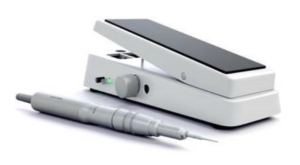
WAW system FUE handheld device
Zeus Ugraft – FUE handheld device wired and wireless
The system features a set of uniquely designed devices that have completely changed the game when it comes to FUE hair transplant procedures. it provides patients with higher quality grafts with greater survival rates. Innovative features work together to make this possible in a way that’s never been done before.
These features include a flared punch tip, an expanded inner volume, an upward pulling action, a unique graft control mechanism, and fluid irrigation with hands-free ejection provided by the Dr.UGraft™ Zues System. (Punches are 18,19,20 gauge)
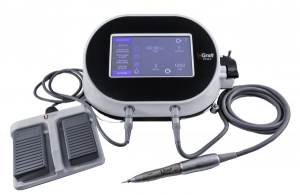
Zeus Ugraft FUE handheld device
There are many other rudimentary devices on the market that only rotate aka core. In most cases the scars from the harvesting area will tell the story of how good the device and the talent of the doctor.
So, which one is better?
Any device is as good as the operator and not the other way around. No device will transform a novice into a master overnight. Some are more talented than others, for sure, but hair transplant in general requires patience, artistic flare, understanding the complex nature of the surgery and passion. This is why I always recommend that if you are going to have a hair transplant chose someone that is doing this every day, NOT someone that added it as padding to their business.
Example:
- Internal medicine doctor that also does hair transplant ……. the odds of you getting a good hair transplant are very low
- Spas
- Any physician that also offer hair transplant in their portfolio, but it is not their primary specialty
All these devices help alleviate pressure on the doctor both in their hands as well as in their feet. One of the main issues with performing these types of procedures without the assistance of a device like these, is doctor fatigue. ARTAS when it came to market, was offered only to the top doctors that intended to use them as an addition, NOT a replacement of them.
I have chosen carefully my devices, and my results speak to that end. As you can see all the devices look to alleviate doctor fatigue. I started doing needle point and “goblen” when I was a teenager, and it developed into a passion.
My decision making on which device to choose was not made on doctor fatigue criteria. Why? Because I am used to do repetitive motion over long periods instead, I chose to select based on, how healthy the harvested grafts and transection rate percentage, are with these tools.
The foundation of a great hair transplant are health of graft and the less trauma on the graft. My results speak to the potential of the chosen devices.
The holy grail today is to get a device with a variety of punch sizes so you can adjust accordingly harvest healthy grafts, low transection rates and minimally detectable scars.
Conclusion
When comparing these devices, it’s essential to consider several factors:
- The technology’s precision
- The invasiveness of the procedure
- The recovery time
- The naturalness of the results
The physician’s expertise with the chosen device also plays a significant role in the outcome. Therefore, a skilled practitioner can achieve excellent results with both manual and other systems. Therefore, it’s not just about the device but also the physician’s proficiency in using it to craft the most natural-looking results.
Patients should engage in thorough discussions with their physicians about why they prefer a particular device and ask to see the device. Understanding the rationale behind the choice can provide insights into the expected results and the overall experience. Additionally, researching and reading reviews from other patients who have undergone procedures with these devices can be helpful.
Ultimately, the best FUE device is the one that aligns with the patient’s specific needs, the physician’s skill set and the desired outcome. It’s a decision that can be made after careful consideration of all these factors and in-depth and diligent research.
I love to educate the patient on what options they have so give us a call at 480-525-4547 and start your journey of hair restorations with me.
References:
Cole Instruments- Medical & Surgical Tools – Cole Instruments Store

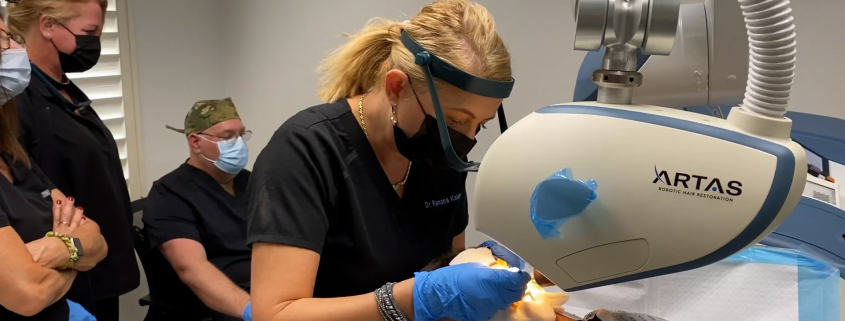

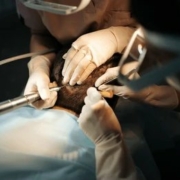

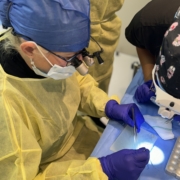 Hair4LifeMed
Hair4LifeMed